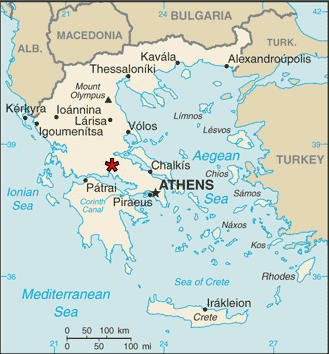
The Toilets and Other Plumbing of Delphi
The Toilets of Delphi / Δελφοί
Delphi, in Greece northwest of Athens, was a major religious center over a period of two millenia from 1600 BC until 395 AD. It was initially dedicated to Gaia, the west Asian Mother Goddess, and later was dedicated to the Greek gods Poseidon and Apollo. Pilgrims would go through purifying rituals before visiting the site, using various springs, baths, and fountains.
Diodorus Siculus wrote in the first century BC about a much earlier goat herder named Coretas. One of his goats fell into a crevasse in the ground and began behaving strangely. Coretas climbed down into the crevasse and found that he was filled with a divine presence, and he could see out of the present into the past and the future.
Coretas told nearby villagers, who started visiting the crevasse and experiencing the convulsions and inspired trances. Yes, sure, some villagers disappeared down into the crevasse in their frenzied state, but that's a risk that comes with theophanies!
By 1600 BC a shrine had been erected at the site. The shrine was initially dedicated to Gaia, the Mother Goddess of west Asia, according to Aeschylus in the prologue of his Eumenides.
Then the myth held that the office of Oracle was held by the goddesses Themis and Phoebe. Later, the site was believed to be sacred to Poseidon, the deity of earthquakes known as "Earth-Shaker". During the Greek Dark Ages (11th-9th century BC), the temple was turned over to Apollo.
A modern interpretation holds that Apollo was a late addition to the Greek pantheon from Lydia, in today's Turkey, and that he was originally the Mesopotamian diety Aplu, an Akkadian name for "son".
Then there is the silly sounding deity Απόλλων Σμινθεύς, or Apollon Smintheus, Apollo Mouse-Killer. Mice aren't the top of the food chain, but they are a source of disease and so old Mouse-Killer gets credit for preventative medicine.
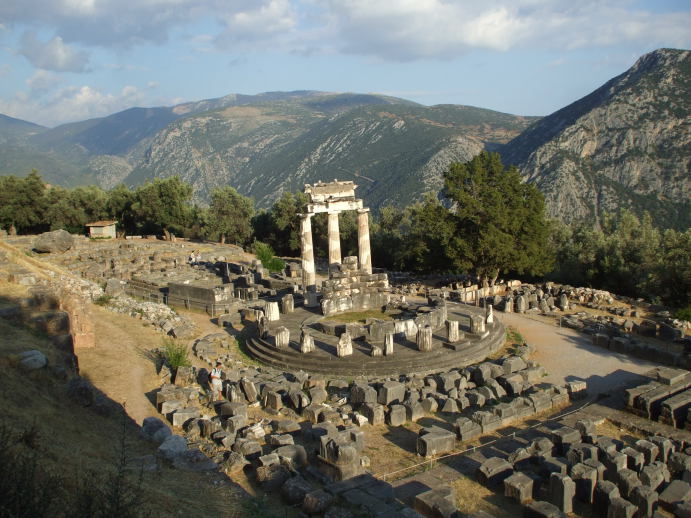
The Tholos at Delphi.
The Tholos was constructed in 380-360 BC. It had 20 Doric columns around an outer perimeter with a diameter of 14.76 meters, and with 10 Corinthian columns in the interior. It is said to have been built by Theodorus the Phocian.
Oracular activity continued until 395 AD, when Byzantine Emperor Theodosius I shut it down. The famous final pronouncement of the oracle predicted the end of Delphi and, with it, the Empire.
Theodosius I was dead within two years, and within 20 years the Western Roman Empire had finished falling to the barbarians. Hmmm. The Oracle got this one right.
Back in the day, pilgrims coming to Delphi would land at the shore of the Gulf of Corinth, several miles away. They would proceed up the valley below the sacred site, turning and approaching by way of the Tholos. They would purify themself on the way toward the most sacred area where the Oracle presided.
Now there is a convenient toilet and sink near the Tholos, so modern day pilgrims can purify themselves, or at least, well, you know.
No shelter has Apollo, nor sacred laurel leaves;
The fountains are now silent; the voice is stilled.
It is finished.
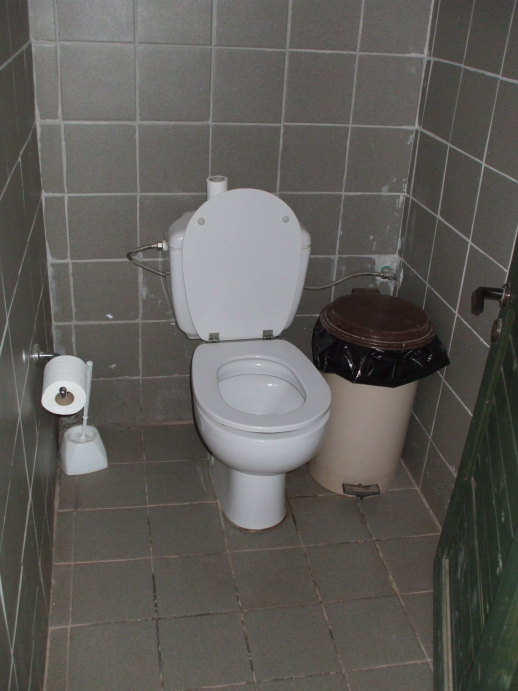
Here you can see the facility at the left edge of the frame, with the Tholos in the distance at right and the dramatic valley further away in the distance.
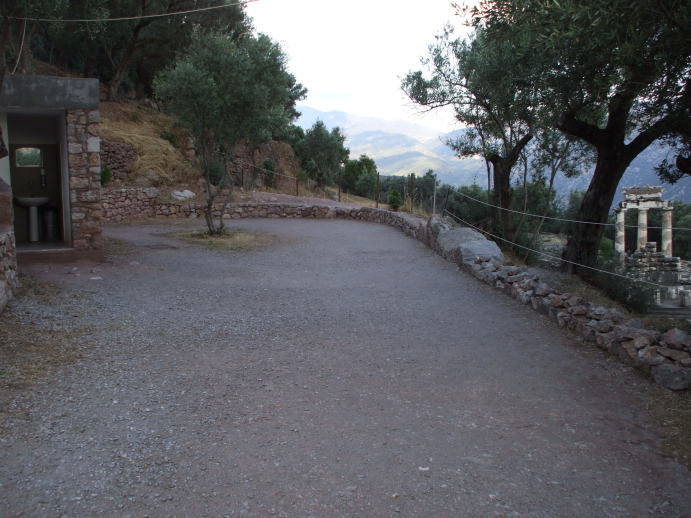
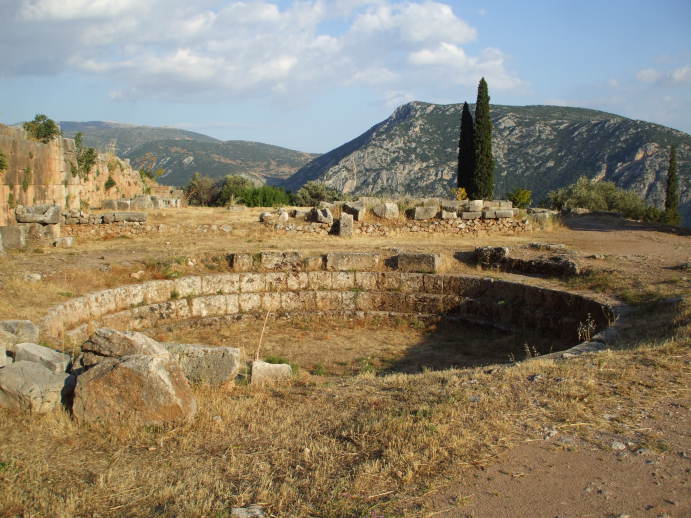
Back to the history...
Continuing west, following the geography and jumping back and forth in time, we come to the gymnasium and its (plumbing related!) baths. This originally dates from the 4th century BC, but was rebuilt by the Romans. The circular frigidarium or cold bath was 9 meters in diameter and 1.8 meters deep.
Looking the opposite direction, up the tall and steep slopes of the southern wall of the valley, we see a ravine separating the two Phaedriades, the two peaks overlooking Delphi.
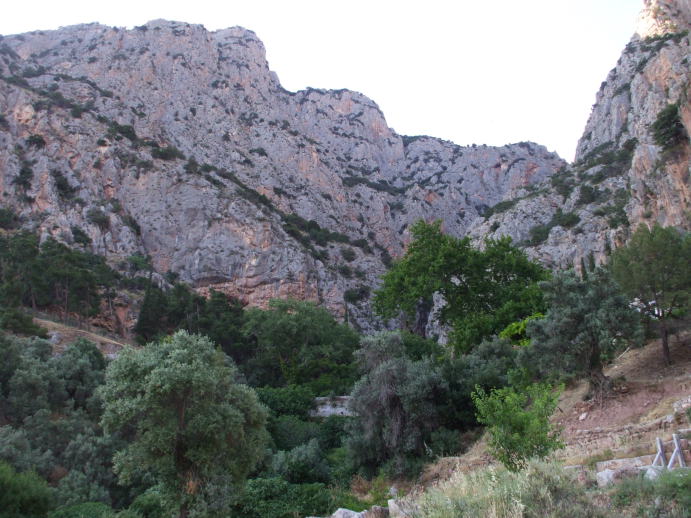
And, where the modern road crosses that ravine, as seen here, you still find the spring of the Castalian Fountain. The area of the fountain itself is frequently blocked off because of falling rock.
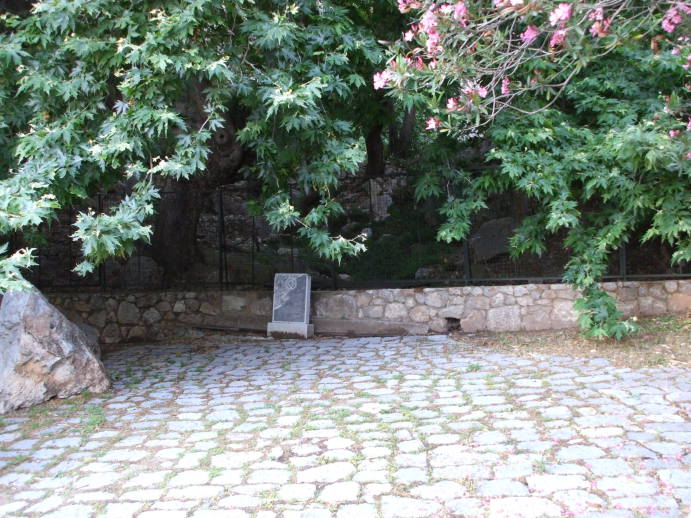
The very recently excavated Castalian Bath, seen here, is where all visitors to Delphi stopped to wash their hair. It is also where the Roman era poets paused to receive inspiration. This was believed to be the very spot where Apollo killed the monster, Python, and so it was especially sacred.
The Castalian Spring and sacred bathing for cleansing purposes date back to Mother Goddess days, long before the Delphi of Classical Greek tradition.
What you see here is a 6th century BC marble-lined basin surrounded by benches.
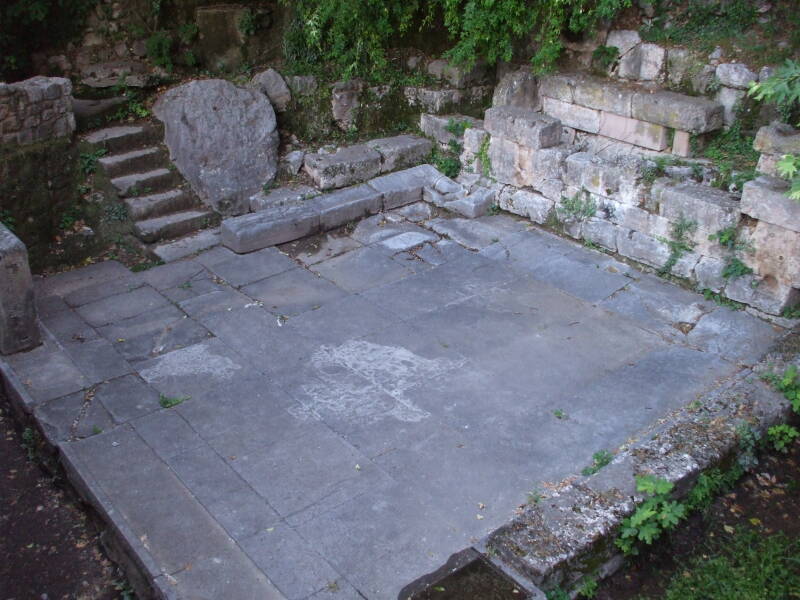
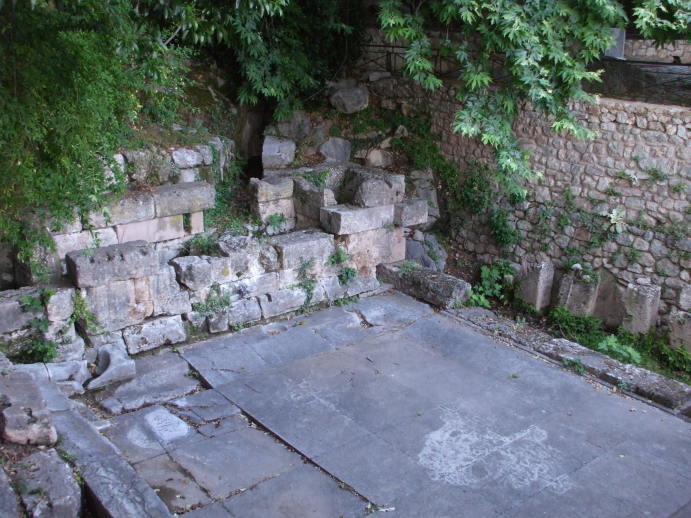
Here is the main temple in Delphi, what everything was building up to — the Temple of Apollo.
The front of the temple, its entrance, was at the far or left end in this view, the end toward the mountain.
For those allowed to enter the temple, the Sanctum Sanctorum, the Holiest of Holies, was at the opposite end of the temple, nearest the viewpoint in these pictures.
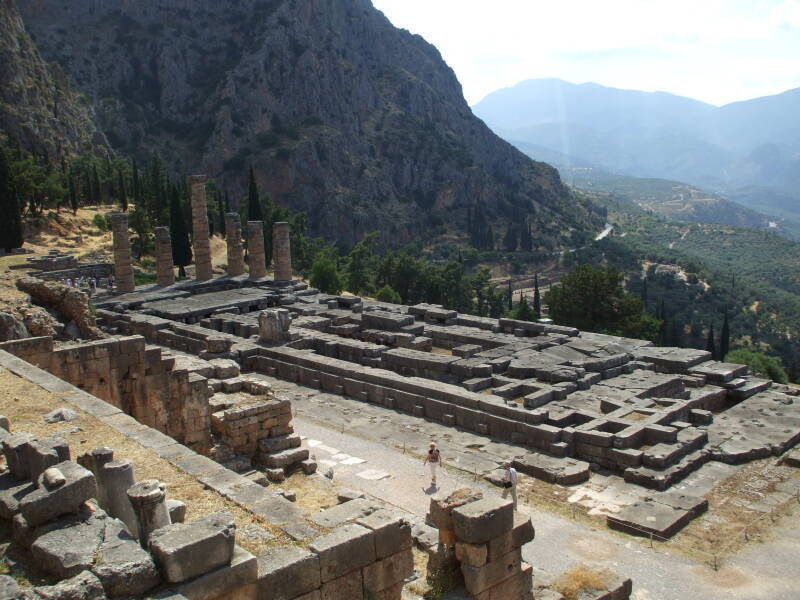
This was where the Pythia or the Oracle of Delphi sat on a tripod above a crevasse. It seems that the crevasse emitted ethylene gas, and that this ethylene seep led to the Oracle's strange mental states. Ethylene is known to cause a mixed euphoria and frenzy followed by little to no recollection of one's actions or altered speech during the period of intoxication.
The idea was that the god Apollo spoke through his Oracle, also known as the Pythia.
The Pythia had to be a woman "of blameless life" chosen from the peasants of the area. She sat on a tripod over a crevice. Apollo was said to have killed and buried a mythic Python, really a dragon and not a large snake as the term now means. The temple was thought to be built over the buried dragon, or the chthonic Python in the parlance of their time.
The fumes rising from the decaying body of the Python would intoxicate the Oracle (or Pythia, get it?) and put her into a trance in which Apollo possessed her.
The Oracle would babble semi-coherently. Her ravings would then be "translated" by the temple priests into elegant hexameters.
See the area toward the rear of the temple, at the opposite end from the standing partial columns. The Oracle's seat and crevasse are thought to have been in the area where the large stone floor plates are tilted together.
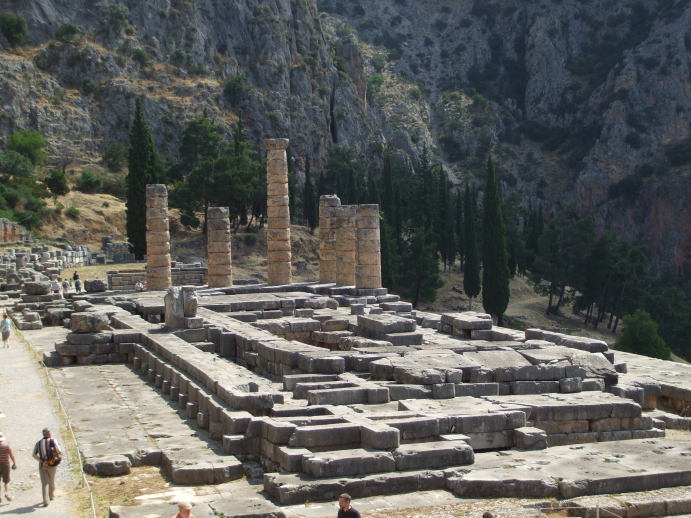
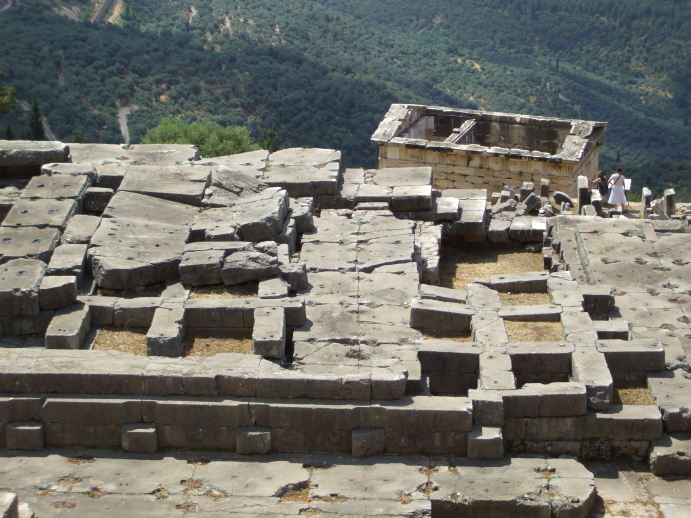
If you go to the south side, the long downhill face of the temple, toward the southwest corner (downhill and away from the entry end), you may spot this passage leading back toward the area underneath the Oracle's seat!
Yes, you can crawl back into that passageway.
But alas, there seems to be no active ethylene seep.
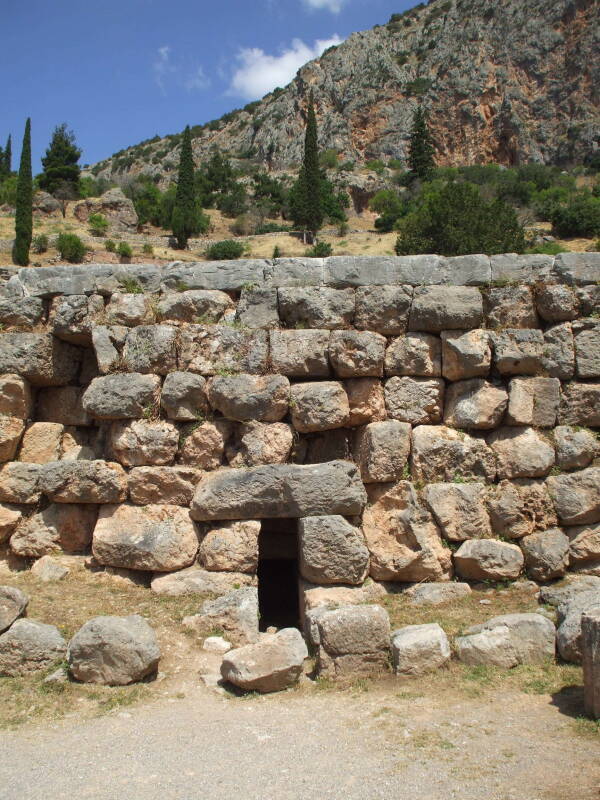
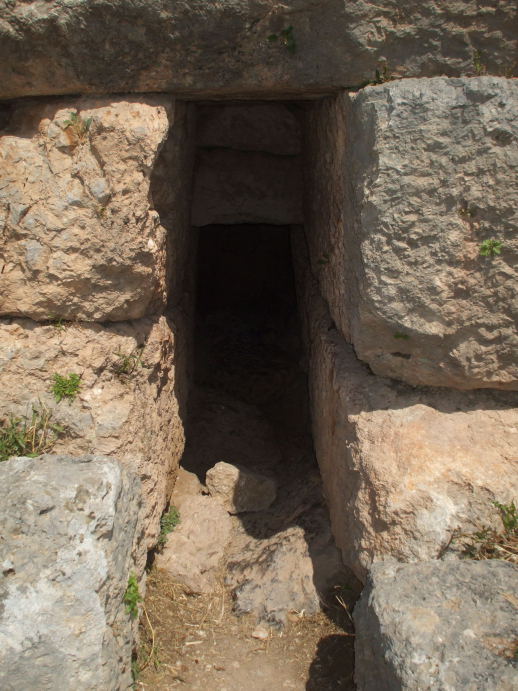
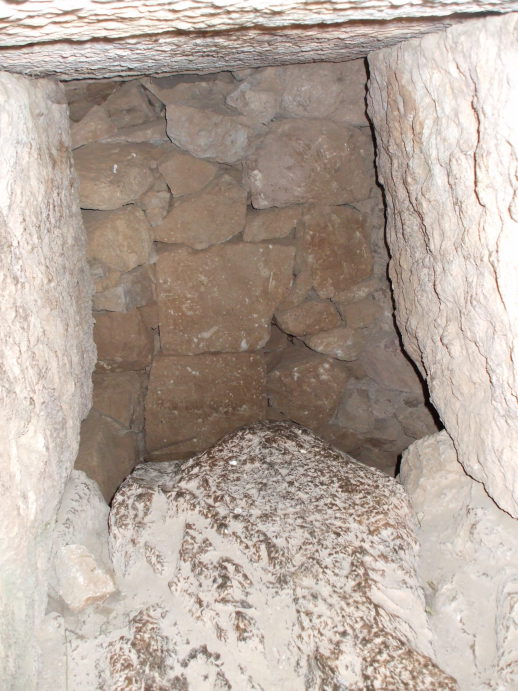
Meanwhile, there is a modern public toilet at the archaeological site. It's seatless, and the toilet paper is stashed up on top of the high tank.
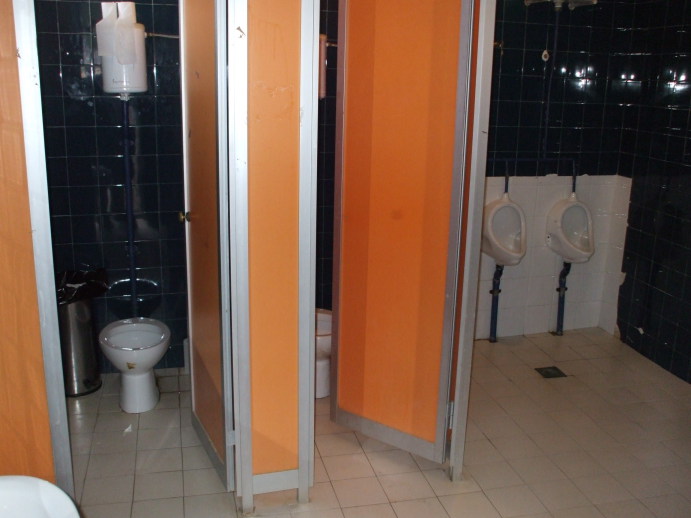
Of course, they didn't use toilet paper back in the era of the oracle!
If neither a tersorium nor water were available, the Greeks and Romans used πεσσοι or pessoi, small stones, to clean themselves. The tradition started with the ancient Greeks that three stones should be enough to finish the job. This convention has been very long lived, with a hādīth attributed to Muhammad specifying three stones as the ideal number for anal cleaning. The pessoi were also used in an ancient board game in Greece. Aristophanes wrote a scene involving pessoi in Peace in the 5th century BCE. Here's the Penguin Classics translation:
Arms dealer [displaying a cuirass]: And what, alack, shall I do with this rounded cuirass, a beautiful fit, worth ten minas?
Trygaeus: Well, that one will not make a loss for you, anyway. Give me that at cost price. It will be very convenient to crap in ...
Arms dealer: Stop this impudent mockery of my goods!
Trygaeus [placing the cuirass on the ground like a chamber pot and squatting on it]: Like this, if you put three stones beside it. Is it not clever?
The Greeks would use όστρακα or ostraka, small pieces of broken ceramic goods, to vote to shun or ban their opponents. This is where we get the word ostracize. Some scholars have suggested that the ostraka could be used as pessoi, literally wiping your feces onto the names of hated individuals. The abrasive characteristics of broken ceramic material suggest that long-term used of these as pessoi could have resulted in localized irritation at the least, progressing to skin or mucosal damage or the irritation of external hemorrhoids. For more on toilet use of pessoi and ostraka and the medical implications see the paper "Toilet hygiene in the classical era", Philippe Charlier, Luc Brun, Clarisse Prêtre, and Isabelle Huynh-Charlier, in BMJ (the British Medical Journal) 2012, pages 345-346.
